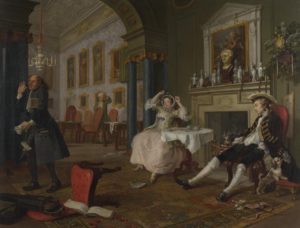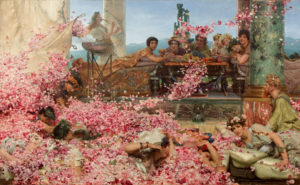Stepping Through the Frame: How Paintings Influence Movies
Because of their seemingly serious subject matter, movies about art and artists can serve as a quick way for a director, an actor, or a screenwriter to garner some attention and a bit of critical acclaim. While they’re rarely ever nominated for best picture at the Academy Awards, artist biopics are often the sole sources of information about an artist that are accessible to many people. Films like Frida, Pollock, and Big Eyes cover modern and contemporary icons like Frida Kahlo, Jackson Pollock, and Margaret Keane, respectively. Some of the older masters have also gotten their time in the cinematic spotlight, from Michelangelo in The Agony and the Ecstasy, to J.M.W. Turner in Mr. Turner, to the medieval Russian icon painter Andrei Rublev in the monumental 1966 Soviet film that bears his name. Van Gogh has gotten particular attention recently, with two incredible movies, Loving Vincent and At Eternity’s Gate, released within a little over a year of each other. These films have had a remarkable effect on how society views these artists and their work.
But the life of an individual artist is not the only thing one can see on the screen. Often an artist can go unnamed, yet their work can shape the feel, cinematography, and even the entire design of a film. One of the most cited examples of this influence comes from a Stanley Kubrick cinematic masterpiece. In creating his 1975 film Barry Lyndon, chronicling the life of an Irish adventurer and his aristocratic aspirations, Kubrick used the catalogues raisonnés of many great eighteenth-century British artists to encapsulate the feel of the period. The design team used portraiture by Joshua Reynolds and Thomas Gainsborough to create period-appropriate costumes. When filming outdoors, Kubrick framed his shots in a manner reminiscent of John Constable’s landscapes. Furthermore, all the interior shots exclusively used natural light from windows and candles, giving many scenes a tenebrism similar to Joseph Wright of Derby’s paintings. But the single painter who had the most significant influence on the production was William Hogarth. Not only was Hogarth a respected painter, but he became one of Britain’s most prominent social critics through his art. He was mainly known for his series of paintings about moral decline. His series Marriage A-la-Mode shows an ill-fated marriage between a wealthy merchant’s daughter and an aristocrat’s son. The most recognizable installment in the series is the second painting entitled The Tête à Tête, popularly known as the Breakfast Scene. The wealthy newlyweds sit at their breakfast table, with the wife stretching and yawning, while the husband sits slouching in his chair with his legs lazily spread out in front of him. The various items strewn across the floor, plus a guest in the act of waking himself in the background, are indicative of the previous night’s revelry. The husband also has a noticeable blotch on his neck, likely from some venereal disease, while a sniffing dog draws attention to another woman’s knickers stuffed into his jacket pocket. Not only do the clothing and interior decoration appear to influence Barry Lyndon’s design, but the layout of the figures and the themes of financial irresponsibility and moral degradation are also apparent.
Barry Lyndon is far from the only film influenced in this way. It may be surprising to learn that nearly all the great movies set in the ancient world have been shaped by the work of a single nineteenth-century artist. The Dutch-born British painter Lawrence Alma-Tadema is known for his academic paintings showing life in ancient Egypt and Rome. He was a perfectionist, ensuring accuracy up to the most minor details. For his 1888 work The Roses of Heliogabalus, Alma-Tadema shows an actual banquet held by the Roman emperor Elagabalus in the third century CE. As a practical joke, the teenage emperor installed a false ceiling in his dining room, filling the space above it with literal tons of flowers. When the ceiling was removed, these flowers fell in such great heaps that some guests were smothered to death. Alma-Tadema not only tried to replicate the clothing and architecture typical of third-century Rome, but he scheduled regular deliveries of French roses over four months to have the right visual aides to complete the piece.
Alma-Tadema’s Egyptian works were also immensely popular, with The Finding of Moses being one of his most influential works. In the production of The Ten Commandments, Cecil B. DeMille told his set designers to study Alma-Tadema’s Egyptian works, particularly The Finding of Moses. Through works like A Pyrrhic Dance and Caracalla and Geta, Alma-Tadema was also extensively studied in the design of Ben Hur and Gladiator, both of which won the Academy Award for Best Picture. Consequently, many of the great movies set in the ancient world have been influenced in one way or another by Alma-Tadema’s work: from Oscar-nominated greats like Cleopatra and Spartacus, all the way to Monty Python’s Life of Brian.
But some paintings can be seen in relation to movies even before you walk into the theater. Movie posters have almost become artworks in their own right, and certain similarities can be observed across multiple posters and identified as clichés. One such poster cliché is the main character with their back turned looking out into empty space; from Star Trek Into Darkness to Captain America: Winter Soldier, and from Inception to Despicable Me 2. But this layout is nothing more than a repeated copy of Caspar David Friedrich’s romantic icon Wanderer Above the Sea of Fog. But whether it’s something as little as the poster hanging in a theater lobby, or something as all-encompassing as the film's design, art has continually shaped the way our movies are made. So, who knows? Be prepared to see shots from an upcoming film resembling a David Hockney, or a new Disney protagonist that looks like a Takashi Murakami figure — just warning you.


